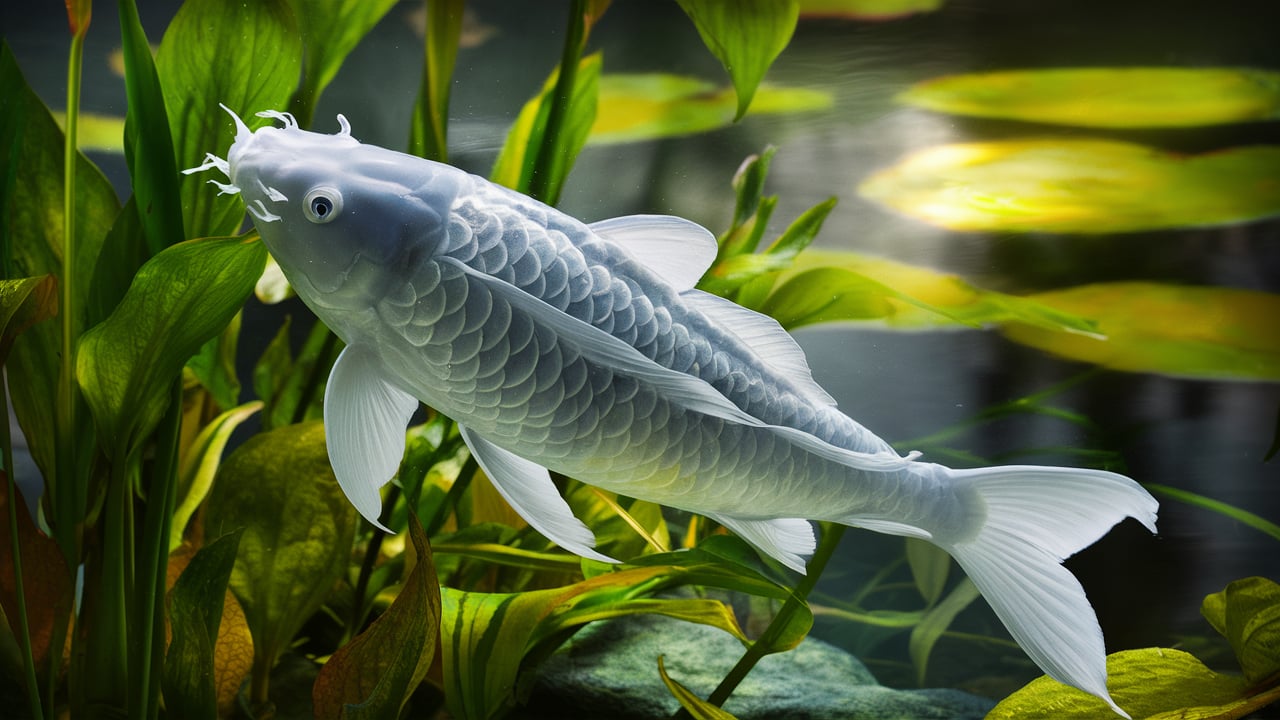Ghost Koi Carp, also known as “ghost koi,” refers to koi fish that have an almost entirely white or silver coloration, creating a mysterious and unusual appearance. Join Koi Fish Beauty as we explore the fascinating world of Ghost Koi Carp, delving into their origins, meaning, and the captivating stories surrounding this unique koi species.
The Truth About Ghost Koi Carp
Origin and Genetics
Genetic Mutation
Ghost Carp are not a separate breed of koi but rather the result of genetic mutations that occur during breeding. This type of mutation reduces the amount of melanin pigment in the fish’s body, making them paler than regular koi.
Breeding Process
According to experts, Ghost Carp can be created by breeding koi with pale colors together. However, this breeding process is often very difficult and has a low success rate.
Physical Characteristics
Color
Ghost Carp typically have an almost entirely white or silver color, with very small black or red spots.
Scales
The scales of Ghost Carp are usually white or silver, creating a sleek and shimmering appearance.
Shape
The shape of Ghost Carp is similar to that of regular koi, with a streamlined body and broad tail fins.
Meaning and Culture
Symbol of Good Luck
In Japanese culture, Ghost Carp are seen as symbols of good luck, prosperity, and purity.
Legends of Ghost Koi
There are many legends about Ghost Carp, including a story about a ghost koi that helped a man escape an accident.
Aesthetic Value
Ghost Carp are highly valued for their aesthetic appeal due to their unique and mysterious appearance.

Are Ghost Koi Carp really ghost fish?
No, Ghost Carp are not actually ghost fish. The term “ghost” refers to their unusual, almost entirely white or silver coloration, which gives them a mysterious and ethereal appearance.
The term “ghost” is a descriptive term used to highlight their unique color, not to suggest they are supernatural creatures. They are still regular koi fish, just with a rare genetic mutation that reduces their pigmentation.
While there are legends and stories surrounding Ghost Carp, these are just cultural narratives and not evidence of them being actual ghost fish.
Are Ghost Carp more valuable than regular koi?
Yes, Ghost Carp are generally considered more valuable than regular koi, but there are a few factors that influence their price:
- Rarity: Ghost Koi Carp are rarer than regular koi due to the genetic mutation that causes their unique coloration. This rarity drives up their value.
- Coloration: Ghost Carp with a pure white or silver coloration, with minimal markings, are highly sought after and command higher prices.
- Size and Quality: Larger, healthy Ghost Carp with good body shape and finnage are more valuable than smaller or less healthy specimens.
- Bloodline: Koi with a known lineage from reputable breeders or with a history of producing high-quality offspring are typically more expensive.
- Demand: The demand for Ghost Carp can fluctuate based on market trends and the availability of fish.
However, it’s important to note:
- Not all Ghost Koi Carp are expensive: Some Ghost Carp with less desirable coloration or smaller size may be priced similarly to regular koi.
- Value is subjective: The value of a Ghost Carp can vary depending on the individual buyer’s preferences and the specific market they are in.
Tips for Keeping Ghost Koi Carp
Here are some tips for keeping Ghost Carp healthy and happy:
Diet
- Variety is key: Ghost Carp need a balanced diet that includes both high-quality pellets and live foods.
- Pellets: Choose pellets specifically formulated for koi, with high protein and low phosphorus content.
- Live foods: Offer a variety of live foods like brine shrimp, bloodworms, and daphnia.
- Greens: Include greens like blanched spinach, romaine lettuce, and zucchini in their diet for added fiber and nutrients.
- Frequency: Feed them twice a day, in the morning and evening, but only as much as they can consume within a few minutes. Overfeeding can lead to water quality issues.
Living Environment
- Spacious pond or tank: Ghost Carp need ample space to swim and thrive. Aim for at least 50 gallons of water per koi.
- Clean water: Maintain good water quality with regular water changes and filtration.
- Temperature: Ghost Carp prefer water temperatures between 68-77°F (20-25°C).
- Oxygenation: Ensure adequate oxygen levels in the water with a good air pump or fountain.
- Substrate: Use a gravel or sand substrate that is easy to clean and won’t harm the koi’s fins.
- Plants: Add water plants to the pond or tank to provide shade and natural filtration.
Health Care
- Regular observation: Monitor your Ghost Carp for any signs of illness, such as lethargy, loss of appetite, or changes in behavior.
- Quarantine: Always quarantine new koi before introducing them to your existing pond or tank to prevent the spread of disease.
- Veterinary care: Consult a veterinarian specializing in aquatic animals for any health concerns.
- Parasite prevention: Use parasite treatments as recommended by your veterinarian.
- Stress reduction: Avoid overhandling and sudden changes in their environment to minimize stress.
Additional Tips
- Consider the size: Ghost Carp can grow quite large, so make sure your pond or tank is big enough to accommodate their adult size.
- Socialization: Ghost Carp are generally social fish and do well in groups.
- Patience: It takes time to establish a healthy environment for your Ghost Carp. Be patient and consistent with their care.
Conclusion
Ghost Koi Carp are a special type of koi fish, possessing a mysterious beauty and profound meaning. Owning a Ghost Carp not only brings joy and good luck but also provides a way to connect with Japanese culture and legends.

Related Posts
Chagoi Koi Fish – The Majestic Giants Of The Pond
Sanke Koi Fish: A Journey Into Elegance And Refinement
Ki Utsuri Koi: The Majestic Beauty Of Black And White Koi